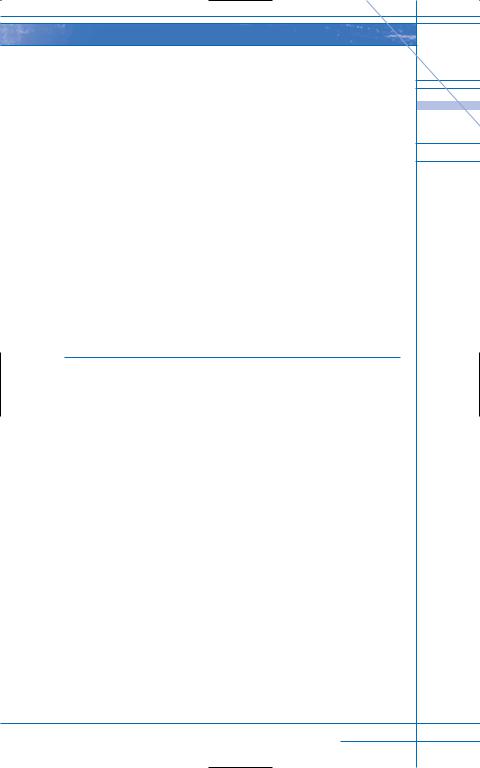
- •Table of Contents
- •Introduction
- •The 5 Dramatic Throughlines
- •The 6 Conflicts
- •The 21 Genres
- •The Replay
- •Fate
- •The Parallel
- •The Episodic
- •The Journey
- •Interactive
- •Metafiction
- •The Slice of Life
- •Introducing the 55 Dramatic Situations
- •Situations 1 & 2
- •Situations 3 & 4
- •Situations 5 & 6
- •Situations 7 & 8
- •Situations 15 & 16
- •Situations 17 & 18
- •Situations 43 & 44
- •Situations 45 & 46
- •Situations 47 & 48
- •Situations 49 & 50
- •Situations 51 & 52
- •Research

The Replay
FROM RASHOMON:
PRIEST: If men don’t trust each other, this earth might as well be hell.
COMMONER: Right. The world’s a kind of hell.
PRIEST: No! I don’t want to believe that!
COMMONER: No one will hear you, no matter how loud you shout. Just think. Which one of these stories do you believe?
WOODCUTTER: None makes any sense.
COMMONER: Don’t worry about it. It isn’t as if men were reasonable.
The Replay is defined as having two to three versions of events in one story. These versions may come from the point of view of one character over and over again as in Run Lola
Run and Groundhog Day, where one character lives out the events in her life several times, or from several characters, one after the other as in He Said, She Said and Rashomon where there are two to three characters who relate their version of the same story.
The Character Is Defeated Throughline is hard to pull off here because it would call for the character being defeated in every version of the story that is shown. Of course it can be done, but the reader usually wants to see the character prevail at some point in this type of story, even if she abandons her Goal in the end. We would all love to be given a second chance to do things differently because we believe we would be successful at it the second (or third) time around.
Replay Structure
There is still a sense of a clear three-act beginning, middle, and end to the Replay:
Act I |
Act II |
Act III |
The Replay |
39 |

Replay structure can be either plot driven or character driven. In the plot-driven type, the plot is the main focus of the story. In each version of the story the plot changes and the characters react to those changes. In Rashomon the three characters accused of a crime, and their accusers, all react to the different versions of the crime that are given as testimony by each of the accused.
In the character-driven type, the character is the main focus of the story. In each version, the story remains the same but the character changes his approach to the events. In Groundhog Day, Bill Murray relives the same day over and over again until he learns his lessons and changes his behavior. No one else knows the day repeated itself.
The Replay Elements
ACT I TRADITIONAL ELEMENTS
•Setup
•Mood or Tone
•Hook
•Problem
•Main Characters
ACT I NEW ELEMENTS
The Time Merge is set up. Somehow the reader knows several different versions of a story are going to be presented. In film, this can be done by fading-out and fad- ing-in, color washing, or other visual techniques. In novels, this can be done with any type of page break to show that a division in time has taken place. You can be as creative as needed to get the message across to the reader. If you are presenting versions of the events from different characters, then it is as if each character steps forward to tell her version of the story, one after the other. Either way, this breaking of linear time usually happens right away or at least by the end of the first representation of the story, which is usually at the end of Act I. It all depends at which point you want to clue the reader in as to what is going on.
All characters must be introduced here to keep coherence. Since the story will be presented several times, the reader needs to know who the players are and why they are
40 Story Structure Architect

there. This way the reader can see how they change within each version presented.
There must be a strong focus within the story being presented so it is easy to see where a character deviates from her previous actions. In a plot-driven story, show what makes the different version different. In a character-driven story, show why the character needs to change as he repeats the story over and over again.
Act I should end with a Reversal: “We are now going to see the story again.” In a plot-driven story, a new character comes forward to tell her version of the story. In a char- acter-driven story, the character is taken back to the beginning of the story to relive the events
There may or may not be a Villain in this type of story. If the Main Character is living the same events over and over again, he could be his own worst enemy, which is why he needs to learn some lessons and change his ways.
ACT I QUESTIONS
•Does the Main Character know right away that the events are repeating?
•Will this be plot or character driven? Why?
•Can you add anything to make the versions more dramatic or distinctive?
•Are there any characters you can’t introduce right away?
•Will there be a Villain?
ACT II TRADITIONAL ELEMENTS
•Problem Intensifies: If the story is plot driven, the Problem Intensifies according to the reason it is important to find out which version of events is the truth. Is a criminal facing death row? If the story is character driven, the Problem Intensifies according to the reason why it is important for the character to get out of the replaying of events.
•Temporary Triumph: For a moment it seems as if the new story version is more successful or truthful than the first one seen.
•Reversal: We are going to see this story again because we still have doubts and questions.
ACT II NEW ELEMENTS
The new story version raises questions. Is this version more successful or more truthful than the version just presented? What has changed? Which version should be believed? Has the Main Character’s goal changed?
The Replay |
41 |

Supporting Characters don’t change or go through an arc in this structure as they may with Traditional Structure.
If the story is plot driven, as in the case of Rashomon, they change only according to the opinions of whoever is telling the current version of the story. If the story is character driven, as in the case of Run Lola Run, we learn more about some of the Supporting Characters if the Main Character chooses to do things differently and gets a chance to see more of these characters’ lives. For example, in one version Lola decides to wait longer at a bank, which leads to her learning about her father’s adulterous affair. Her father hasn’t changed; we have just seen more of his life.
ACT II QUESTIONS
•Will the Problem Intensify? Why does the Main Character need to get out of this Replay of events?
•Do we learn more about the Supporting Characters? Why? Does it enhance the story? Or set up the next version to come?
•Will you Replay the events more than once in this act? If so, what are you trying to show?
•What questions are being raised here that you will answer in the final version to come?
•Has the Main Character changed at all?
ACT III TRADITIONAL ELEMENTS
•Final Obstacle: This is the final version of the story. If it is plot driven, will the truth be revealed? If it is character driven, will the Main Character make the right decision this time?
•Climax
•Resolution: Loose ends are tied up, though possibly some have just been done away with as the final story version may omit them altogether.
ACT III NEW ELEMENTS
For the first time the Main Character does something different or sees things differently. The cycle of repetition is broken.
The Main Character may abandon the Goal easily here as is the case when searching for the truth, like Rashomon, because there just may be no definitive answer. In this case there is usually a larger question answered or ex-
42 Story Structure Architect

plored, possibly about what truth itself is. This is where the theme will come out.
The Resolution leaves the reader wondering about the previous events and where the character will go next.
The Climax occurs as the Main Character decides to do something differently or change how she sees things. Things really heat up because the reader wants her to succeed this time. Perhaps the reader knows exactly what she must do to succeed and waits for her to figure it out.
ACT III QUESTIONS
•Is it clear that the Main Character is out of the Replay of events in the end? Or will you leave some question in the reader’s mind?
•How will you make this version more dramatic than the previous ones?
•Will you show the reader what happens after the Main Character is out of the Replay? Does she continue with her life?
•What has the Main Character, or the reader for that matter, learned from seeing this story over and over again?
EXAMPLES
Rashomon, AKIRA KUROSAWA
A heinous crime and its aftermath are recalled from differing points of view.
Groundhog Day, HAROLD RAMIS
A weatherman is reluctantly sent to cover a story about a weather-forecasting groundhog. This is his fourth year on the story, and he makes no effort to hide his frustration. When he awakens the “following” day he discovers that it’s the same day over and over again.
Run Lola Run, TOM TYKWER
Lola must run to save her boyfriend’s life. Her first attempt ends in failure and she repeats the same events, making different decisions, two more times.
The Replay |
43 |
